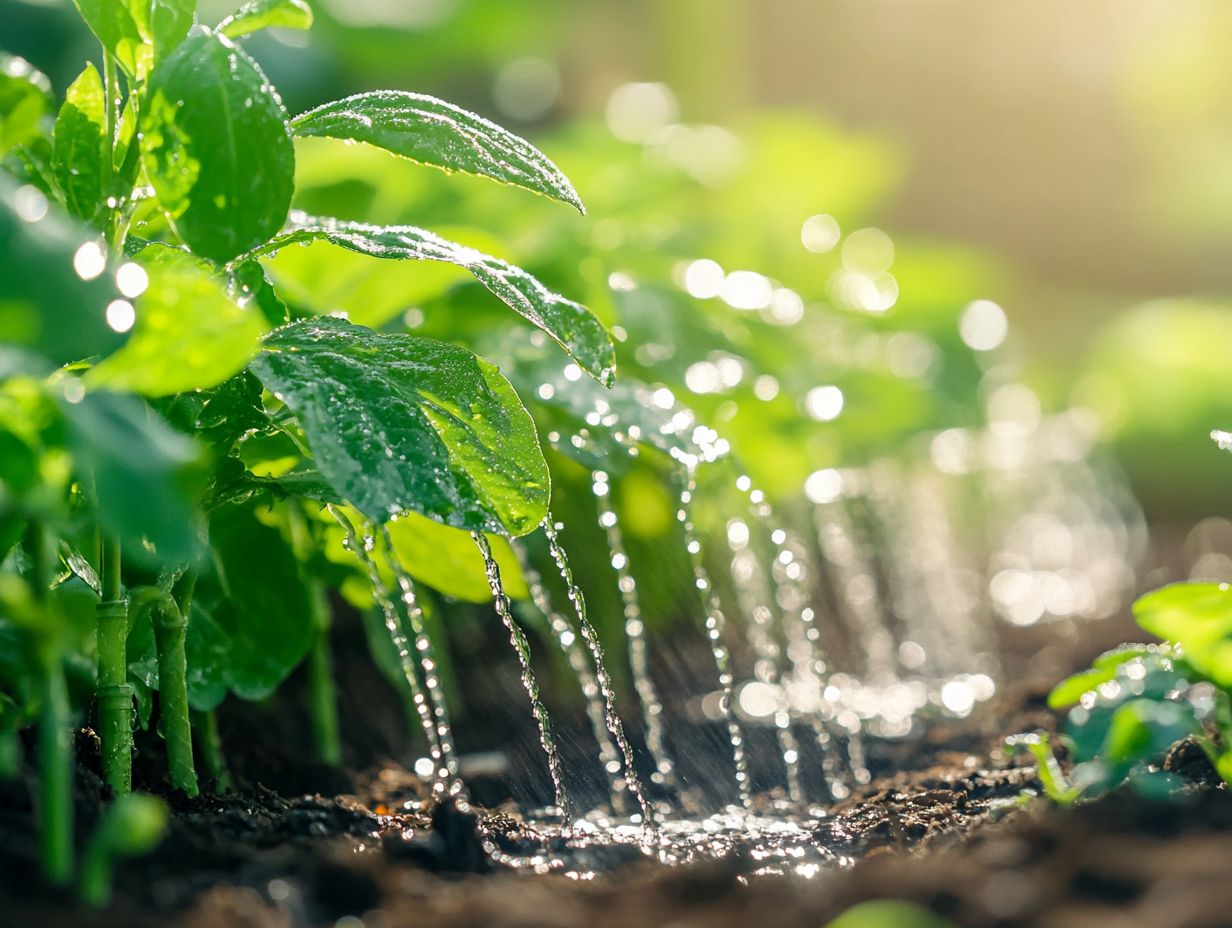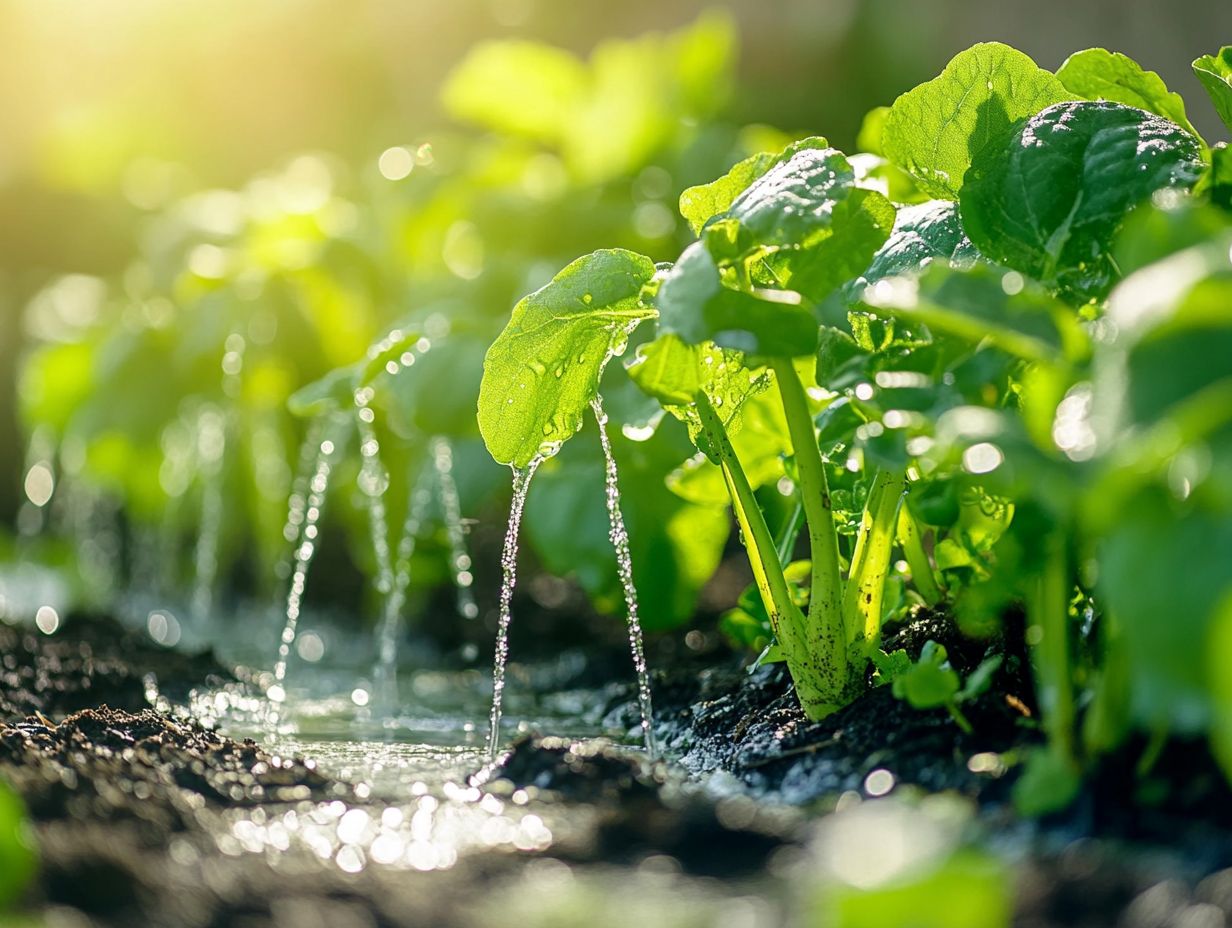Drip Irrigation: A Smart Water Conservation Method
Drip irrigation is transforming how we water gardens and crops. This effective system delivers water directly to the roots of plants, providing just the right amount needed for optimal growth.
Explore the fundamentals of drip irrigation and discover its various benefits. Learn how it enhances plant growth while conserving valuable water resources.
Transform your garden today with drip irrigation! This guide provides tips on the different systems available, installation advice, and financial considerations to empower you to make informed decisions.
Contents
- Key Takeaways:
- What is Drip Irrigation?
- Why Choose Drip Irrigation?
- How Drip Irrigation Works
- Types of Drip Irrigation Systems
- Installation and Maintenance
- Cost and ROI of Drip Irrigation
- Frequently Asked Questions
- What is drip irrigation and how does it conserve water?
- How does drip irrigation differ from traditional watering methods?
- Can drip irrigation be used in all types of gardens?
- What are the benefits of using drip irrigation?
- How do I set up a drip irrigation system?
- Will using drip irrigation save me money?
Key Takeaways:

What is Drip Irrigation?
Drip irrigation is a water-efficient approach in landscape architecture and agriculture, delivering water directly to the roots of your plants. This method reduces evaporation and runoff, optimizing water usage, making it one of the benefits of drip irrigation in drought gardens.
Using a network of tubing and devices that release water slowly, you ensure that your crops and landscapes receive the exact moisture levels they require, especially in drought-prone areas. This carefully designed system gives you precise control over irrigation management, promoting plant health and sustainable practices.
Understanding Drip Irrigation Components
The main components of a drip irrigation system include devices that release water slowly, tubing, and pressure regulation devices. Each part plays a critical role in delivering water efficiently to your plants.
Devices that release water slowly are the heart of your system. They provide water directly at the root zone, minimizing waste and maximizing absorption, ensuring your crops get the moisture they need for optimal growth.
The tubing, typically made from durable polyethylene, transports water from its source to the devices. You can choose from various designs, such as subsurface or surface tubing, based on your landscape’s specific needs.
Pressure regulation devices are essential for maintaining the right flow rate and ensuring even water distribution, preventing runoff and water stress caused by inconsistencies in delivery.
Understanding these components is crucial for anyone looking to create an efficient and sustainable irrigation system.
Why Choose Drip Irrigation?
Drip irrigation offers numerous advantages. You will enjoy significant water conservation, enhanced plant growth, and precise delivery of nutrients directly to the root zone. This makes drip irrigation a great choice for both agricultural practices and careful landscape maintenance.
Water Conservation and Efficiency
Drip irrigation is a premier solution for water conservation, utilizing a precise strategy that minimizes water wastage while effectively optimizing soil moisture levels. Discover more about the benefits of drip irrigation systems to enhance your gardening practices.
Unlike traditional watering methods that often lead to significant runoff and evaporation, this system delivers water directly to plant roots in a slow and steady manner. Studies show that drip irrigation can improve water efficiency by up to 90%, while conventional systems typically achieve only 50-70% efficiency.
Research from the Food and Agriculture Organization indicates that farms using drip irrigation can save between 30% and 50% more water, all while enhancing crop yield and quality. This method alleviates pressure on local water resources and fosters sustainable agricultural practices, making drip irrigation vital in combating water scarcity.
Start your drip irrigation journey today!
Improved Plant Growth and Yield

One of the most significant advantages of drip irrigation is its remarkable ability to enhance plant health and boost crop yield. By providing consistent moisture levels and delivering nutrients directly to the root systems, this technique transforms the way you approach cultivation.
Drip irrigation minimizes water wastage and ensures your plants receive precisely what they need, which is critical during dry spells when rainfall is scarce. By promoting moisture retention in the soil, you can expect substantial improvements in plant vigor and resilience. This directly impacts your crop yield, allowing you to cultivate a diverse array of crops, including those that thrive in drier conditions.
Drip irrigation also helps develop drought-tolerant plants, maintaining agricultural productivity even in the face of climate challenges.
How Drip Irrigation Works
Drip irrigation operates through a sophisticated network of components designed to deliver water at a slow, steady rate directly to the roots of your plants. This method ensures optimal moisture levels while minimizing evaporation loss.
Step-by-Step Process
The process of installing a drip irrigation system requires meticulous planning for watering point placement. This ensures that every plant receives sufficient water while considering maintenance and irrigation management for long-term efficiency.
Start with a thorough site assessment to understand the unique features of your landscape, such as soil type, sun exposure, and the specific water requirements of your plants.
After the assessment, design a layout that maximizes coverage while minimizing water waste. Map out garden beds and determine the optimal positioning of your watering points.
Proper placement of the watering points will ensure that roots can access water effectively. Regular maintenance like checking for clogs, adjusting flow rates, and monitoring for leaks will enhance your system s performance. Use mulch to retain soil moisture and adjust irrigation schedules based on seasonal changes for efficient management.
Types of Drip Irrigation Systems
You ll find a variety of drip irrigation systems available, each crafted to meet specific agricultural practices and landscape requirements.
- Manual setups
- Automated systems with pressure regulation for consistent water flow
Comparing Different Systems
Drip irrigation offers distinct advantages over traditional sprinkler systems in terms of efficiency and water conservation.
Drip systems deliver water directly to the root zone of your plants, minimizing evaporation and runoff two major issues associated with sprinklers. Traditional sprinklers can waste water due to wind drift and overspray, resulting in uneven moisture distribution. Drip irrigation ensures that water is utilized where it s most needed.
While sprinklers may cover larger areas more quickly, they often miss the mark on targeted irrigation. Drip irrigation is more cost-effective in the long run, reducing water usage and lowering your utility bills. Choose drip irrigation and join the many eco-friendly gardeners who are making a difference!
Installation and Maintenance

Proper installation and maintenance of a drip irrigation system are essential for ensuring its long-term efficiency in both landscape maintenance and agricultural practices.
Investing time and effort into these aspects can optimize the system s performance, leading to healthier plants and reduced water waste.
Start your drip irrigation journey today and watch your garden thrive!
Tips for Proper Installation and Care
To achieve optimal results with drip irrigation, it s essential to follow proper installation techniques and ongoing maintenance practices. This includes taking care of the emitters and managing the system effectively.
Position each emitter correctly to deliver just the right amount of water to your plants, significantly boosting growth efficiency. Inspect your setup regularly wait too long, and problems may worsen! Check for clogs, leaks, and pressure inconsistencies to catch issues before they escalate.
Routine cleaning of filters and emitters is key to preventing sediment buildup that can obstruct water flow. Watch for weather changes. Heavy rain or frost requires adjustments. This proactive approach can help your irrigation components last much longer and ensures your garden thrives beautifully.
Cost and ROI of Drip Irrigation
Understanding the cost and return on investment (ROI) of drip irrigation is crucial for farmers and landscapers. While the initial expenses may seem daunting, these costs can be balanced out by substantial water savings and increased crop yields over time.
Financial Considerations
When considering a drip irrigation system, take into account the setup costs, maintenance expenses, and potential returns from improved crop yield and lower water bills. Understanding these factors can significantly impact your decision-making process.
As you budget for installation, consider not only the initial expenses for equipment and labor but also any long-term financing options available. Evaluating your ROI means tracking improvements in water use efficiency and crop output over time, giving you a clearer picture of your savings and benefits.
While the upfront investment may seem considerable, many farmers find that the financial rewards from reduced water costs and increased production can lead to significant long-term returns.
Frequently Asked Questions
What is drip irrigation and how does it conserve water?

Drip irrigation is a method of watering plants by delivering small, precise amounts of water directly to the roots. This method conserves water by minimizing evaporation and runoff.
How does drip irrigation differ from traditional watering methods?
Unlike traditional methods, such as sprinkler systems, drip irrigation delivers water slowly and directly to the plant’s roots. This reduces water waste and promotes healthier plant growth.
Can drip irrigation be used in all types of gardens?
Yes, drip irrigation can be used in all types of gardens, including vegetable gardens, flower beds, and even potted plants. It can also be applied in both outdoor and indoor settings.
What are the benefits of using drip irrigation?
- In addition to conserving water, drip irrigation promotes healthy plant growth by providing consistent moisture.
- It minimizes leaf wetting, which can lead to diseases.
- It saves time and effort by reducing the need for manual watering.
How do I set up a drip irrigation system?
Setting up a drip irrigation system is simple and can be done with basic tools. First, layout the tubing and emitters in the desired locations. Then, connect the tubing to a water source and adjust the flow rate. Finally, cover the tubing with mulch to prevent evaporation and protect the system.
Will using drip irrigation save me money?
Yes, using drip irrigation can save you money in the long run. You ll save on your water bill and on energy costs by reducing the need for traditional watering methods. Healthier plants also mean less money spent on replacements and maintenance.






